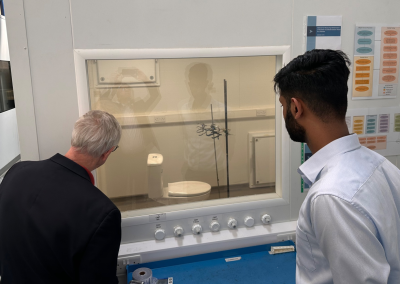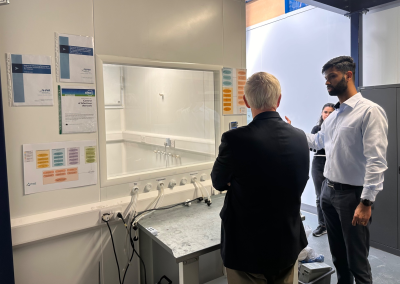by David O’Connor, Associate Professor in the School of Chemical Sciences at Dublin City University (DCU)
How WIBS Works
WIBS identifies airborne bioaerosols by shining ultraviolet (UV) light on particles in the air. This light makes certain biological molecules (e.g. amino acids), like those in bacteria, spores and pollen, fluoresce. WIBS measures this fluorescence to identify the particles. It can detect particles ranging in size from tiny bacteria to larger pollen grains (0.5-30 micron).
The latest models, like the WIBS-NEO, offer even better data quality and can connect to monitoring systems for continuous tracking. This makes WIBS a valuable tool for real-time aerosol monitoring.
Applications of WIBS in Research
Environmental Monitoring
WIBS has been used to sample bioaerosols in various environments (Healy et al., 2014). For example, it has helped scientists study sea fog by detecting particles released from seaweed during low tides. In agricultural areas, WIBS has been used to monitor fungal spores from hay and silage, which are linked to respiratory illnesses like asthma and COPD (O’Connor et al., 2013). This work has provided essential data for assessing the risks associated with bioaerosols in farming environments.
Research near composting sites has demonstrated WIBS’ ability to distinguish between fluorescent and non-fluorescent particles, enabling the differentiation of biological from non-biological aerosols. Such studies have provided insights into the environmental impact of composting activities and informed guidelines for safe operations (O’Connor et al., 2015).
Public Health and Workplace Safety
Airborne bioaerosols like fungal spores and pollen can trigger allergies and worsen asthma. WIBS is helpful for tracking these particles, especially during high-risk times like allergy seasons. It has also been used in workplaces, such as meat processing plants, to identify poorly ventilated areas and reduce the risk of airborne diseases like COVID-19 (Walshe et al., 2021).
WIBS data has been applied to assess aerosol-generating procedures in medical and dental settings. For instance, studies have shown its effectiveness in quantifying the impact of high-speed dental drills and mitigating exposure risks (Fennelly et al., 2022). These applications demonstrate WIBS’ relevance in safeguarding health in both public and occupational environments.
Combining WIBS with New Technology
WIBS data can be enhanced with machine learning and other advanced tools. By analyzing particle size, shape, and fluorescence characteristics, researchers can improve the accuracy of particle identification and even predict where bioaerosols come from (Markey et al., 2022). This integration has led to the development of predictive models that can anticipate bioaerosol behaviors under different environmental conditions, such as changes in humidity or temperature.
This combination of technological innovation and data integration is transforming WIBS from a specialized research tool into a versatile instrument with broad applications in science, public health, and policy-making.
Challenges With and Future of WIBS Technology
WIBS is a remarkable tool, but it has some limitations. It can’t always tell exactly what type of biological particle it detects without additional data. Sometimes different particles produce similar fluorescence characteristics, which can lead to mistakes. Environmental conditions like humidity can also affect its accuracy.
Another challenge is the cost and expertise required to use WIBS. Its price and complexity might make it less accessible for smaller research teams (Droplet Measurement Technologies, 2021). Additionally, the large amount of data it produces requires advanced tools and skills to analyze effectively.
Despite these challenges, ongoing technological advancements are addressing many of these issues. Improved software algorithms and user-friendly interfaces are making WIBS more accessible to a wider audience.
The Wideband Integrated Bioaerosol Sensor is changing how we study airborne particles. Its ability to provide real-time, high-quality data has made it invaluable for tackling challenges in health, climate, and environmental research. From tracking allergens to studying climate change, WIBS offers insights into the dynamics of bioaerosols. As technology advances, WIBS will continue to play a pivotal role in addressing environmental and public health challenges.
References
Fennelly, M., Gallagher, C., Harding, M., et al. (2022). Real-time monitoring of aerosol generating dental procedures. Journal of Dentistry, 120, 104092. https://doi.org/10.1016/j.jdent.2022.104092
O’Connor, D. J., Daly, S. M., & Sodeau, J. R. (2015). On-line monitoring of airborne bioaerosols released from a composting/green waste site. Waste Management, 42, 23–30. https://doi.org/10.1016/j.wasman.2015.04.015
Fennelly, M., Gallagher, C., Harding, M., et al. (2022). Real-time monitoring of aerosol generating dental procedures. Journal of Dentistry, 120, 104092. https://doi.org/10.1016/j.jdent.2022.104092
Droplet Measurement Technologies (2021). WIBS-NEO Operator Manual.
Healy, D. A., Huffman, J. A., O’Connor, D. J., Pöhlker, C., Pöschl, U., & Sodeau, J. R. (2014). Ambient measurements of biological aerosol particles near Killarney, Ireland: A comparison between real-time fluorescence and microscopy techniques. Atmospheric Chemistry and Physics, 14, 8055–8069.
Markey, E., Martinez-Bracero, M., Neeson, F., et al. (2022). A Modified Spectroscopic Approach for the Real-Time Detection of Pollen and Fungal Spores. Sensors, 22(8747). https://doi.org/10.3390/s22228747
O’Connor, D. J., Healy, D. A., & Sodeau, J. R. (2013). The on-line detection of biological particle emissions from selected agricultural materials using the WIBS-4 technique. Atmospheric Environment, 80, 415–425.
Walshe, N., Fennelly, M., Hellebust, S., et al. (2021). Assessment of Environmental and Occupational Risk Factors for the Mitigation and Containment of a COVID-19 Outbreak in a Meat Processing Plant. Frontiers in Public Health, 9(769238). https://doi.org/10.3389/fpubh.2021.769238
About the Author:
 Dr. David O’Connor is an Associate Professor in the School of Chemical Sciences at Dublin City University (DCU), specializing in atmospheric chemistry, particularly bioaerosols and air pollution. His research focuses on understanding the dynamics of biological particles in the air, such as fungal spores and pollen, and their effects on air quality and public health.
Dr. David O’Connor is an Associate Professor in the School of Chemical Sciences at Dublin City University (DCU), specializing in atmospheric chemistry, particularly bioaerosols and air pollution. His research focuses on understanding the dynamics of biological particles in the air, such as fungal spores and pollen, and their effects on air quality and public health.
A key area of Dr. O’Connor’s work involves real-time bioaerosol detection using advanced fluorescence-based techniques, including the Waveband Integrated Bioaerosol Sensor (WIBS). This technology has advanced the study of bioaerosols, improving air quality monitoring and forecasting.
Equally Dr. O’Connor co-authored a study mapping nitrogen dioxide (NO₂) and particulate matter (PM₂.₅) in Dublin, highlighting pollution hotspots and the need for targeted solutions. As lead researcher on the BOHEMIAN project, he is developing Ireland’s first bioaerosol forecast model in collaboration with University College Dublin and Met Éireann.
Widely published and cited, Dr. O’Connor’s work is advancing our understanding of bioaerosols and their role in atmospheric chemistry (Evaluating background and local contributions and identifying traffic-related pollutant hotspots: insights from Google Air View mobile monitoring in Dublin, Ireland).


